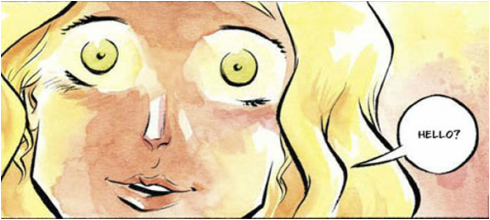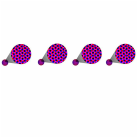review by jai hutchisonAuthor- Neil Gaiman Adaptation, Art and Lettering- Fábio Moon & Gabriel Bá Publisher- Headline I first read ‘How to talk to Girls at Parties’ almost a decade ago now, as a curious short story within Neil Gaiman’s award winning ‘Fragile Things: Short Fictions & Wonders’, and I just loved it. What started off as a lighthearted and humorous tale, left me with a haunted and uneasy feeling oozing through me, and I just could not shake it. The story itself is set in Croydon in the 1970’s and focuses on teenage friends Enn and Vic who, after being stuck at an all boys school most of their time, are tonight hoping to get lucky at a party full of girls whom they met on a foreign exchange trip. Enn is the wallflower of the two boys, shy and a bit awkward around the ladies, whereas Vic sees himself as a bit of a ladies man, and with quite a bit of experience behind him he cannot wait to get to this party and put his moves on the “Girls! Girls! Girls!” that he is so eager to meet. Due to Vic’s one track mind however, the boys unknowingly end up crashing the wrong party; where foreign exchange suddenly has a whole new meaning. The boys are quickly drawn inside and hypnotised by the beautiful, albeit slightly peculiar appearing Stella. Vic disappears with Stella, while our wallflower, encouraged by his best friend with the earth shattering advice of “You've just got to talk... Just talk to them”, tries to work on his confidence and charm as he introduces himself to girl after girl as the night goes on; each one slightly more strange than the last; in behaviour as well as appearance. The story is actually narrated by Enn, and one of the main things I recall from reading this story the first time around is being inside Enn’s head and having so many intense things described to me. I remember being in imagination overdrive as I so often am with Gaiman’s work (he truly has a gift), and I remember saying to myself as Enn narrates “I want to see what he can see, I need to see what he is seeing”. And now here we have it, this gorgeous adaptation by the award winning brothers Fábio Moon and Gabriel Bá. Now I can see what Enn is seeing. I instantly loved the artwork. Bá and Moon have complimented the story magnificently. There’s always an anxiety when a piece of prose you love is being adapted to a different medium that it will lose something, at the very least may be conveyed slightly differently, or at worst can lose its entire essence and become barley recognisable. Fortunately, neither scenario presented itself with this project as these guys did an extraordinary job with “How to talk to girls at parties”. In an interview with Blastr Bá and Moon talk about how they had to choose which parts of Gaiman’s prose to keep for the comic book and which to lose, and yet when reading it, it feels complete; you would never guess that parts of the original prose had been removed. The brothers credit this in the Blastr interview to their artwork being very narrative, which it truly is; just as Gaiman creates such a strong visual presence and beautiful story telling with his words, Bá and Moon really fulfil the same role with their artwork. The story was all there in beautiful watercolours, and from panel to panel the story just flowed so naturally. To paint the picture they created fantastic street scenes of Croydon with terraced housing, East Croydon Station and they even included the NLA Tower. Then as the story progressed the art became more intense and creative, and I really enjoyed that it evolved from the precise and clear street scenes to the more elaborate party scenes and the versatility of the watercolours worked brilliantly for this. Some of my favourite panels in this comic are when Enn and Triolet are together. It’s explosive. The colours are so intense and what has been created on these pages here is just gorgeous. It really adds another level of excitement to Enn and Triolet’s story and also creates more excitement around Triolet's character. One of the things I loved about ‘How to Talk to Girls at Parties’ is the range of emotions it took me through in such a short amount of time. I think it will vary for each reader depending on their age, sex and life experiences but for me there were moments when I couldn’t stop laughing but also moments of fear, sadness, panic, happiness and annoyance. For such a short story there is still a lot going on within it, which is what makes it so intense, and also what makes it so great. As well as the emotional roller coaster that this story takes the reader on, it can also be interpreted from two different perspectives. On the one hand you can just take it literally and purely enjoy it as a bizarre sci-fi comic about two horny teenage boys who end up quite out of their depth at the wrong party; one of whom tries to overcome his social awkwardness to find love, or even just a kiss, and the other has an unknown traumatic experience. Or, on reflection the story could also be taken as a comical metaphor about teenagers seeing those that they are attracted to as alien. I found it quite ironic and funny the way in which Enn describes girls and what happens to them as they get older; he talks about them as if they are in fact another species or aliens, its hilarious: “When you start out as kids, you're just boys and girls, going through time at the same speed. And then one day there’s a lurch and the girls just sort of sprint off ahead of you… and they know all about everything. And they have periods, and breasts, and makeup and God-only-knew-what-else… for I certainly didn’t.”
Our story nears an end with Vic crashing downstairs and awaking Enn from Triolet’s trance. And at that they ran. Now when I read the short story in “Fragile Things: Short Fictions & Wonders” I was left with a horrible feeling in the pit of my stomach, an eerie sensation throughout, but also the burning questions of what did they see? Eyes like what? I was beyond curious to see what Enn and Vic could see standing on the stairs, because all my imagination could piece together and paint was this feeling of fear and then utter darkness. This question hung over me, and it bugged me. Until comic book artists Gabriel Bá and Fábio Moon collaborated with Neil Gaiman and adapted this fantastic short story and brought us “How to Talk to Girls At Parties”: The Graphic Novel. When I bought my copy it took everything in my willpower (which isn’t that much, but you get my point) not to flip through the pages to that part of the story to see how the artwork turned out. Although their use of watercolours is stunning throughout this comic book, I just felt that the image of Stella on the staircase was somewhat anticlimactic. I admit that my opinion is probably due to the fact that I have read the story previously as I do love the art throughout the rest of this comic, very much so. I do not want to disdain the work of Bá and Moon by any means; I just believe that there is a lot to be said for one's imagination. You can purchase 'How to Talk to Girls at Parties' here, from Headline. Or if you'd like to try the original short story, you can purchase that here. Neil Gaiman’s ‘How to Talk to Girls at Parties’ is also being adapted into a movie with a slightly different take on the original story line. It will star Elle Fanning and Nicole Kidman, and be directed by John Cameron Mitchell. Look out for it in cinemas in 2017.
0 Comments
|
Back issues
July 2024
|





 RSS Feed
RSS Feed